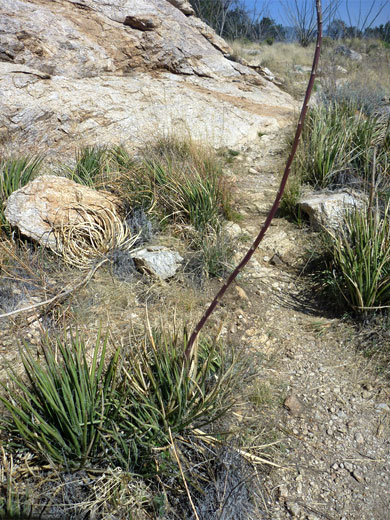Scientific name:
Agave schottii
Common name:
Schott's agave
Range:
Southeast Arizona, extreme southwest New Mexico
Form:
Small, untidy rosettes of short, closely-spaced leaves, forming large clusters
Habitat:
Gravel or rocky soils; grassland, scrubland, pinyon, juniper and oak woodland
Flowers:
Yellow, in clusters along or close to the 5 to 13 foot high stalk
Schott's agave is one of the more untidy-looking plants of this genus, forming dense, low, clusters of upwards-pointing, unsymmetrical, green or yellowish green leaves, completely lacking teeth but sometimes edged by thin white filaments. Leaves grow to between 10 and 15 inches in length, topped by a half inch, grey or brown spine.
Var schottii, the most common type, has narrower, yellowish green leaves (less than half an inch) with edge filaments, while var treleasei (which may be a hybrid) has greener leaves up to one inch across and no edge filaments; this is found only in a small area of south Arizona, in the mountains north of Tucson. Schottii flowers form right along the stalk (spicate), while those of treleasei are somewhat branched (paniculate).
Both varieties are somewhat rare and are protected; var treleasei is listed in the highly safeguarded category. Var schottii may be seen in such locations as Saguaro National Park, the Santa Catalina Mountains and the Santa Rita Mountains.
Var schottii, the most common type, has narrower, yellowish green leaves (less than half an inch) with edge filaments, while var treleasei (which may be a hybrid) has greener leaves up to one inch across and no edge filaments; this is found only in a small area of south Arizona, in the mountains north of Tucson. Schottii flowers form right along the stalk (spicate), while those of treleasei are somewhat branched (paniculate).
Both varieties are somewhat rare and are protected; var treleasei is listed in the highly safeguarded category. Var schottii may be seen in such locations as Saguaro National Park, the Santa Catalina Mountains and the Santa Rita Mountains.
All Contents © Copyright The American Southwest | Comments and Questions | Contribute | Affiliate Marketing Disclosure | Site Map




